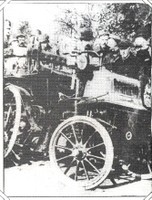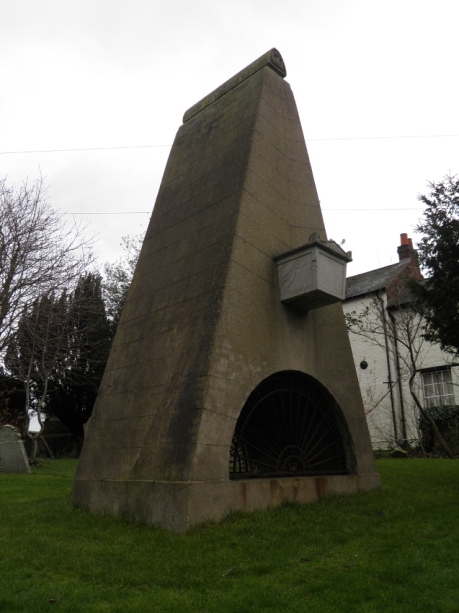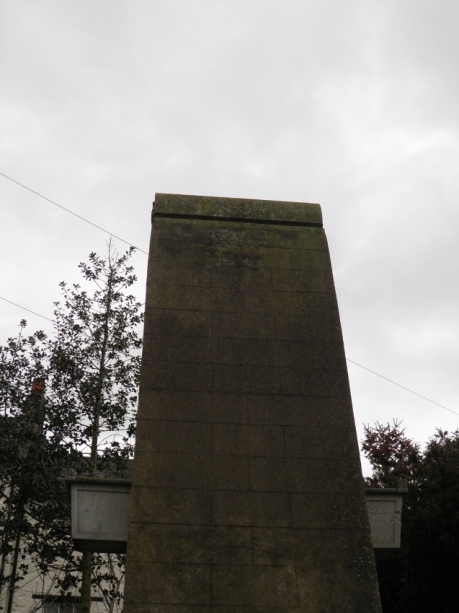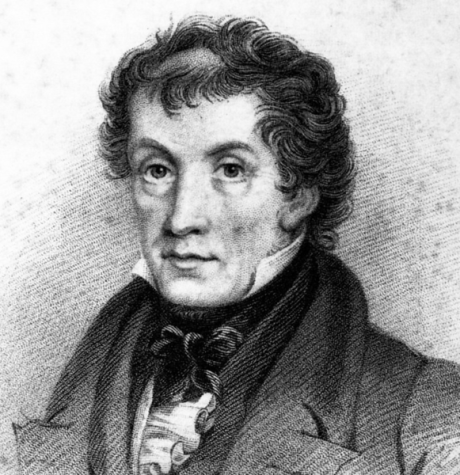O’erwhelmed with gore! The transport death pioneers of Harrow
October 19, 2012
As a child growing up in nearby Hatch End, the gravestone of John Port was always a highlight of a visit to St Mary’s Church in Harrow On The Hill.
On the afternoon of 7 August 1838, Port was a guard on the London to Birmingham train and as it travelled through Harrow, he slipped and fell while walking between the carriages to check tickets. Both his legs were severed as the train went over him and he died later that day from massive blood loss.
The coroner’s inquest found that:
the unfortunate deceased started with the Denbigh Hall five o-clock train on Tuesday last from the station at Euston grove, and having arrived within a mile and a quarter of Harrow, as was the usual custom, he dismounted from his seat for the purpose of collecting from the passengers what is termed the ‘excess fares.’ … In the performance of this duty the deceased was engaged on Tuesday, which compelled him to pass from one carriage to the other by the steps, and when in the act of placing his foot on one of them, at the time the train was proceeding at upwards of thirty miles an hour, his foot slipped between the wheels, which as they successivley passed over, dragged his legs in, crushing them inch by inch up to one of his knees and above the other.
His tombstone bears a gruesome poetic account of the incident.
- TO THE MEMORY OF
- THOMAS PORT
- SON OF JOHN PORT OF BURTON UPON TRENT
- IN THE COUNTY OF STAFFORD, HAT MANUFACTURER,
- WHO NEAR THIS TOWN HAD BOTH HIS LEGS
- SEVERED FROM HIS BODY BY THE RAILWAY TRAIN.
- WITH THE GREATEST FORTITUDE HE BORE A
- SECOND AMPUTATION BY THE SURGEONS, AND
- DIED FROM LOSS OF BLOOD.
- AUGUST 7TH 1838 AGED 33 YEARS.
- Bright rose the morn and vig’rous’ rose poor Port.
- Gay on the Train he used his wonted sport:
- Ere noon arrived his mangled form they bore,
- With pain distorted and o’erwhelmed with gore:
- When evening came to close the fatal day,
- A mutilated corpse the sufferer lay.
Over the years, the headstone has eroded to the point of near illegibility, despite being Grade II listed in 1983.
Port’s death came only eight years after the first ever British rail fatality, that of William Huskisson MP, who died in similar circumstances.
At the opening of the Manchester to Liverpool railway, he “lost his balance in clambering into the carriage and fell back upon the rails in front of the Dart, the advancing engine” which then ran over his leg, severing it. Huskisson died of blood loss, having “lingered in great agony for nine hours.”
Surprisingly, there is also a memorial nearby for another transport-fatality pioneer.
Two minutes stroll down the hill, on the corner of Grove Hill, is a plaque commemorating the first car driver ever to die in a road accident.
The driver, Mr E.R. Sewell had been demonstrating the vehicle, a Daimler Wagonette, to 63-year-old Major James Stanley Richer, Department Head at the Army & Navy Stores, with the view to a possible purchase for the company.As they drove down the hill at 14mph, a wheel shed it’s rim. Both Sewell and Richer were thrown from the car onto the road.
Sewell died instantly, and when Major Richer died four days after the accident without regaining consciousness, it became a dubious double-first – the first death of a driver in Britain, followed by the first death of a passenger in a car
The dubious accolade of being the first person to be killed by a car in Britain goes to Mrs Bridget Driscoll of Old Town, Croydon who on 17 August 1896 was run over by a Roger-Benz car while attending a folk dancing festival at Crystal Palace.
The driver was going at 4 mph (described by witness as “a reckless pace”), and at Mrs Driscoll’s inquest, Coroner William Percy Morrison said he hoped that “such a thing would never happen again.” He was also the first to apply the term ‘accident’ to violence caused by speed.
Since then, some 30 million people have lost their lives in car accidents, but a woman from Croydon is the name which appears at the very top of the list.
The Short Tragic Life of Allegra Byron
October 19, 2012
Just to the right of the doorway of St Mary’s Church, at the summit of Harrow On The Hill, is a small memorial tablet dedicated to Allegra, daughter of Lord Byron and Claire Clairmont.
The lack of detail on the stone hides one of the most poignant, saddest tales in literary history.
Born in Bath in January 1817, Allegra Byron was the illegitimate daughter of Lord Byron and Claire Clairmont (1798-1879), the teenage stepsister of the writer Mary Shelley.
She had relentlessly pursued Byron, and despite thinking her “foolish”, the combination of her advances and his weakness for women was too much: “I never loved her nor pretended to love her—but a man is a man–& if a girl of eighteen comes prancing to you at all hours of the night—there is but one way.”
Byron in 1822
When the child was born, Byron was in Venice, and showed little interest in ‘the little being’ who had been named Alba in his absence. The child’s birth coincided with a time when Byron was at his most dissolute: a time, according to Edna O’Brien in Byron in Love, he was “bargaining with mothers and father for their daughters, brazenly naming his conquests from contessas to cobblers’ wives and claiming to have ‘tooled’ with two hundred women of one sort or another.”
Considering his lifestyle, his decision to have the child sent to him when she was a year old seems positively bizarre. The penniless Claire believed their daughter would be guaranteed a better future with her famous father, and sent him “my child because I love her too well to keep her.” Although she could not have realised it, she would never see her daughter again.
Claire Clairmont
None of her many heartbroken, pleading letters to Byron would ever be answered and worse, his deep-rooted animosity for Claire was passed on to his child.
Byron had decided to “acknowledge and breed” his daughter, albeit in a conditional way – he gave her the surname Biron to distinguish her from his legitimate daughter and renamed her Allegra (its meaning of ‘cheerful, brisk’ couldn’t be a less accurate premonition of the child’s fate.) The first meeting between father and infant daughter was not promising: “My bastard came three days ago,” he wrote. “Heathy – noisy – & capricious.”
Within months, Byron had tired of Allegra and placed her in the care of the British Consul-General Richard Belgrave Hoppner and his wife, neither of whom were very fond of the child. When they left Venice, Allegra was passed on to their servant Antonio and then to the wife of the Danish Consul, “by which time she showed the remoteness of an abandoned child.”
At the same time, Byron was indulging in any romantic encounter which came his way, contracting myriad sexually transmitted diseases and writing his vast blasphemous and bawdy work Don Juan, published anonymously in 1819.
Byron’s feelings for his banished daughter veered between irritation and repulsion. Sent to a convent for her perceived attitude – at three years old, he said she was “obstinate as a mule and ravenous as a vulture” – Byron received a letter from Allegra.
My dear Papa – it being fair time I should so much like a visit from my Papa as I have many desires to satisfy; will you please your Allegra who loves you so?
The abbess of the convent included her own note inviting Byron to come to see Allegra before he left for Pisa and assuring him “how much she is loved.” On the back of this letter, Byron wrote: “Sincere enough, but not very flattering – for she wants to see me because ‘it is the fair’ to get some paternal Gingerbread – I suppose.”
Byron never responded to Allegra’s letter and never visited the child during the thirteen months she was in the convent.
In 1822, as Claire begged to see her daughter again – “I can no longer resist the internal inexplicable feeling which haunts me that I shall never see her anymore. I entreat you to destroy this feeling by allowing me to see her” – Byron sent Allegra even further away, to the Capuchin convent in distant Bagnacavallo.
Shelley and Byron had become friends after Claire had introduced them (their friendship quickly shattered due to Byron’s debauched behaviour), and the poet visited Allegra (who was effectively his niece) at the convent. Bringing her a gold chain as a present, he found the ‘shy and serious’ child expressing the wish that she would one day be visited by her mother or father. Claire was so desparate to see her daughter that she considered kidnapping her, or forging a letter in Byron’s hand directing her to be returned to England.
Sadly, any plans she was devising came too late. During the summer, Byron received word that Allegra had been “ill, dangerously ill” and as he half-heartedly arranged for her to conveyed to a doctor, she died “of a convulsive catarrhal attack” (most likely either typhus or malaria.)
She was just five years old, and had spent the last four of those effectively alone.
Whether it was genuine grief, or deep, unassailable guilt regarding the way he’d acted during his daughter’s short life, Byron was devastated by the news about the detested child he’d completely abandoned. When he was first told:
A mortal paleness spread over his face, his strength failed him and he sunk into a seat…He remained immovable in the same attitude for an hour and no consolation seemed to reach his ears, let alone his heart.
It was a “stunning and unexpected” blow, Byron told Shelley, but he refused to publicly admit his feelings or conduct towards Allegra had been anything but perfect.
Three years after Allegra died, however, he told the Countess of Blessington that her death had filled him with retrospective grief:
Let the object of affection be snatched away by death, and how is all the pain ever inflicted upon them avenged! The same imagination that led us to slight or overlook their sufferings, now that they are forever lost to us, magnifies their estimable qualities … How did I feel this when my daughter, Allegra, died! While she lived, her existence never seemed necessary to my happiness; but no sooner did I lose her, than it appeared to me as if I could not live without her.
Having never visited the convent while she was alive, Byron made a pilgrimage to it after her death, and gave what remained of her clothes for a statue to be erected on the grounds.
Allegra’s tiny body was sent back to England – “the body is embarked – in what ship – I know not’ – and a ghoulish rumour circulated that the child was sent back to England in two parts to save money. Whilst untrue, it’s existence hints as just how depraved the people of England believed Byron to be.
In fact, Byron lavished more attention on Allegra’s corpse than he ever had while she was breathing. She was conveyed from the London Wharf in a fine hearse and mourning coach, drawn by horses festooned with feathers and velvet; her destination was St Mary’s Church on Harrow-on-the-Hill.
The church was chosen as Byron spent many boyhood hours in the churchyard while a schoolboy at Harrow between 1801-1805, and it inspired his 1807 poem Lines Written beneath an Elm in the Churchyard of Harrow.
He knew exactly where he wanted her to be laid. “There is,” he wrote in May 1822, “a spot in the church’yard’, near the footpath, on the brow of the hill looking towards Windsor, and a tomb under a large tree (bearing the name of Peachie, or Peachey), where I used to sit for hours and hours when a boy. This was my favourite spot; but as I wish to erect a tablet to her memory, the body had better be deposited in the ‘church’.”
Byron composed a eulogy to be carved on a marble tablet inside the church door, commemorating “the memory of Allegra, daughter of George Gordon Lord Byron” and quoting a verse from Samuel: “I shall go to her but she shall not return to me.”
But the Rector of Harrow, the Revd John William Cunningham, and the churchwardens considered Byron so immoral, they refused the stone, citing Allegra’s illegitimacy which was compounded by the identification of the father’s name (it’s also likely Byron’s imfamous immorality helped sway their decision.) As such, Allegra was buried in an unmarked plot outside the door of the South Porch.
It was only in 1980 that a memorial tablet was erected on the side of the church near to the place she was interred.
Following Byron’s death from a fever in Greece, his remains were returned to England and a squabble broke out as to where he would be buried – his reputation was such that no one wanted him.
Westminster Abbey refused him burial, as did St Mary’s Church, something which Byron acknowledly sadly at the time of Allegra’s death.
The spot he had chosen for her grave, he wrote in a letter to his publisher John Murray, was the very one “where I once hoped to have laid my own.”
Lord Byron on his Death-bed by Joseph Denis Odevaere (c.1826)
The Floating Coffin of Pinner
February 20, 2012
At the top of Pinner’s medieval high street, shielded from sight by the L’Orient restaurant, sits the 14th century St John’s Church.
In the small graveyard that skirts the church (sadly, it was entirely refurbished in flint in 1880, so little of the ancient building remains) is a unique wedge-shaped memorial.
Halfway up, a coffin seems to protrude, an end jutting out of each side, as if it’s been picked up and hurled through the centre of the triangular monument.
It was remarked upon by Charles Harper in 1902, in his book Cycle Rides Around London.
An odd tomb, in the shape of a tower, is to be seen in the churchyard. Now thickly overgrown with ivy, it is a picturesque object, but the peculiarity of it is that the body of the person “buried” here a certain William London, in 1809 is contained in a stone-encased coffin, projecting from the tower, half-way up. The end of the coffin bears an epitaph, which, however, affords no clue to this freak.
Legends, that may or may not be well founded, tell that the descendants of William London, a Scotch merchant, retain the property bequeathed by him so long as he remains “above ground.” This tower is supported on arches filled in with ornamental ironwork, on which appear the mysterious words, “BYDE-MY TYME.” The inquisitive stranger naturally wants to know what he is waiting for, but the mystery is insoluble.
The strange tomb was erected by acclaimed landscape gardener and prolific horticultural author John Claudius Loudon (1783-1843) to the memory of his parents William (d. 1810) and Agnes (died 1841.)

Loudon’s major work was Arboretum et Fruticetum Britannicum (1838), a guide to every species of shrub and tree growing in Britain, complete with their history, the conditions they favoured and illustrations drawn from life. It took Loudon eight years from start until the publication of the final part.
During that time, he developed the influential concept of ‘gardenesque’ planting – whereby plants were placed in such a way that they formed pleasing patterns, and gardens became a clear product of the gardener’s art, rather than trying to mimic nature.
Along with designing Derby’s arboretum (which inspired the Botanical Gardens at Kew), Loudon was also employed by private companies building large, suburban cemeteries to replace the overcrowded city churchyards – a period which coincides with the erection of the memorial to his parents.
Loudon designed cemeteries in Bath, Cambridge and Southampton, and his ideas for public spaces, which he expounded upon in 1843’s On the Laying Out, Planting and managing of Cemeteries, were adopted by Abney Park and the City of London cemeteries. John Claudius did not live for long after the strange monument was erected: he died in 1843 of lung cancer, virtually penniless despite his lifetime of work, and while memorialised on one end of his monument, was buried at Kensal Green.
“Villagers have come up with many theories over the centuries as to its origin and purpose,” wrote James Bond in the local Harrow magazine Limited Edition back in the 1990s. “One legend which will not rest in peace is that the monument is a device to ensure that a legacy considers to be paid to the church – as long as the dearly departed were left above ground.”
It seems unlikely the church would go to such lengths to swindle a dead man’s family out of their full inheritance, and most likely it was simply a rather literal case, even in death, of social climbing (something still alive and well in Pinner today.)
John Claudius Loudon’s unusual monument, completely out of scale with its surroundings, was probably built to signify his parents were above the rest of those buried in the churchyard, and nearer to their God…than thee.
The unique monument was Grade II listed in 1983.























